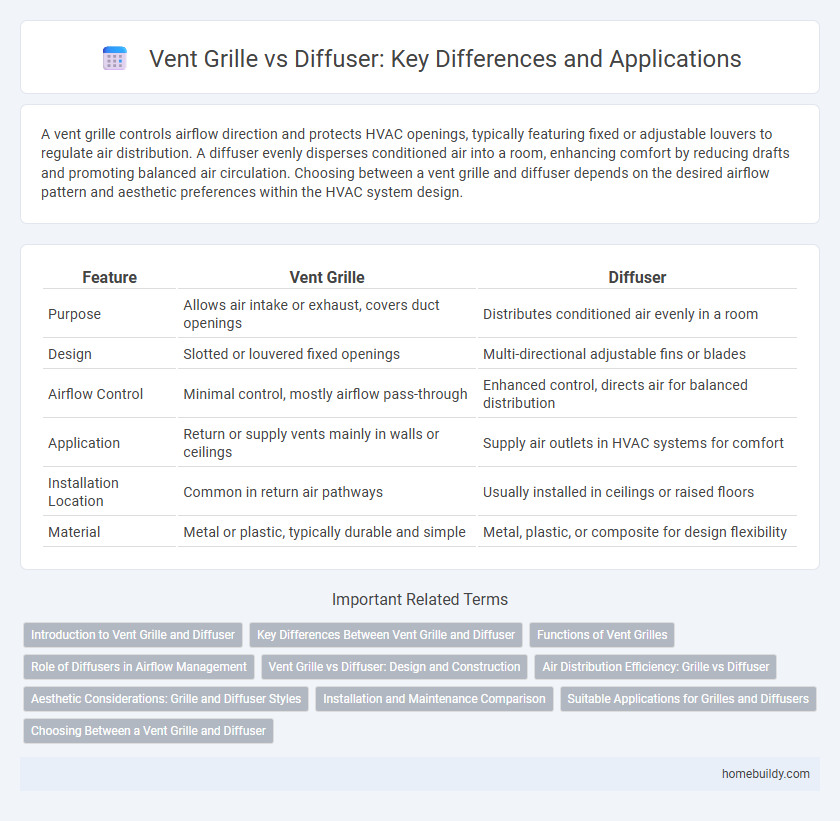A vent grille controls airflow direction and protects HVAC openings, typically featuring fixed or adjustable louvers to regulate air distribution. A diffuser evenly disperses conditioned air into a room, enhancing comfort by reducing drafts and promoting balanced air circulation. Choosing between a vent grille and diffuser depends on the desired airflow pattern and aesthetic preferences within the HVAC system design.
Table of Comparison
| Feature | Vent Grille | Diffuser |
|---|---|---|
| Purpose | Allows air intake or exhaust, covers duct openings | Distributes conditioned air evenly in a room |
| Design | Slotted or louvered fixed openings | Multi-directional adjustable fins or blades |
| Airflow Control | Minimal control, mostly airflow pass-through | Enhanced control, directs air for balanced distribution |
| Application | Return or supply vents mainly in walls or ceilings | Supply air outlets in HVAC systems for comfort |
| Installation Location | Common in return air pathways | Usually installed in ceilings or raised floors |
| Material | Metal or plastic, typically durable and simple | Metal, plastic, or composite for design flexibility |
Introduction to Vent Grille and Diffuser
Vent grilles serve as the primary components that cover air ducts to regulate airflow while providing protection and aesthetic appeal, typically featuring fixed or adjustable slats. Diffusers, on the other hand, are designed to evenly distribute conditioned air throughout a space by controlling the velocity and direction of airflow, often incorporating multiple adjustable blades or perforations. Understanding the functional distinction between vent grilles and diffusers is essential for optimizing HVAC system efficiency and indoor air quality.
Key Differences Between Vent Grille and Diffuser
Vent grilles primarily serve as protective covers for air ducts, allowing air to pass through while preventing debris entry and controlling airflow direction, whereas diffusers distribute air evenly throughout a space to enhance comfort and ventilation efficiency. Vent grilles typically feature fixed or adjustable louvers, while diffusers have adjustable blades or vanes designed to optimize air dispersion patterns. The choice between a vent grille and a diffuser depends on factors such as airflow volume, room size, and desired air distribution characteristics.
Functions of Vent Grilles
Vent grilles primarily regulate airflow and protect ventilation systems by preventing debris from entering ductwork, ensuring efficient air distribution. Unlike diffusers designed to mix and evenly distribute air within a space, vent grilles serve the function of covering air ducts while facilitating air intake or exhaust. Their design optimizes ventilation performance by controlling air volume and direction without altering temperature or air velocity.
Role of Diffusers in Airflow Management
Diffusers play a crucial role in airflow management by evenly distributing conditioned air throughout a space, improving thermal comfort and efficiency. Unlike vent grilles that primarily cover and protect air ducts, diffusers control the direction and velocity of airflow to minimize drafts and ensure balanced ventilation. Their design optimizes air mixing, reducing hot or cold spots and enhancing overall HVAC system performance.
Vent Grille vs Diffuser: Design and Construction
Vent grilles typically feature a fixed or adjustable louver design that directs airflow primarily in one direction, optimizing air intake or exhaust functions. Diffusers, in contrast, have a broader surface with multiple blades arranged to distribute air evenly across a wider area, enhancing air circulation and reducing drafts. The construction of vent grilles often emphasizes durability with metal or plastic materials, while diffusers incorporate design elements aimed at aesthetic appeal and noise reduction.
Air Distribution Efficiency: Grille vs Diffuser
Vent grilles primarily control airflow direction and volume while maintaining aesthetic coverage, focusing on air intake or exhaust with less emphasis on uniform distribution. Diffusers are designed for optimal air distribution efficiency, dispersing conditioned air evenly across a room to enhance thermal comfort and reduce drafts. Choosing a diffuser over a vent grille improves overall HVAC system performance by maximizing airflow reach and minimizing hot or cold spots.
Aesthetic Considerations: Grille and Diffuser Styles
Vent grilles and diffusers offer distinct aesthetic styles that affect interior design choices; vent grilles typically have a simpler, more streamlined appearance with straight or angled slats, providing a minimalist look suited for modern or industrial spaces. Diffusers feature more complex designs with curved vanes or adjustable fins, creating a softer and more decorative element ideal for residential or upscale commercial interiors. Selecting between vent grilles and diffusers involves balancing airflow function with visual appeal to match architectural themes and room aesthetics.
Installation and Maintenance Comparison
Vent grilles typically require simpler installation as they usually mount directly onto duct openings without the need for complex balancing mechanisms, making them easier to fit in residential and commercial spaces. Maintenance involves straightforward cleaning and occasional dust removal since vent grilles have a fixed design with fewer moving parts compared to diffusers. Diffusers, by contrast, often require precise positioning and adjustment for optimal airflow distribution, with maintenance focusing on regular calibration and cleaning of adjustable blades or dampers to ensure efficiency.
Suitable Applications for Grilles and Diffusers
Vent grilles are ideal for applications requiring airflow control in walls, ceilings, and floors, commonly used in residential and commercial HVAC systems to facilitate air return and exhaust. Diffusers are best suited for directing and distributing conditioned air uniformly in occupied spaces, often installed in ceilings of offices, classrooms, and hospitals to enhance comfort and air circulation. Choosing between grilles and diffusers depends on the airflow management needs, with grilles emphasizing ventilation and return air, while diffusers focus on precise air distribution and occupant comfort.
Choosing Between a Vent Grille and Diffuser
Selecting between a vent grille and a diffuser depends on airflow control and aesthetic preferences in HVAC systems. Vent grilles primarily serve as protective covers that facilitate air passage with less control over distribution, while diffusers effectively disperse air evenly throughout a room to enhance comfort. Understanding the specific ventilation needs and space design can guide the optimal choice for efficient air circulation and system performance.
vent grille vs diffuser Infographic

 homebuildy.com
homebuildy.com